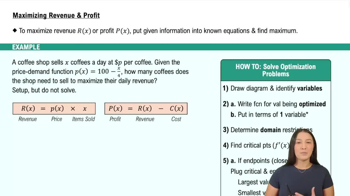Table of contents
- 0. Functions7h 52m
- Introduction to Functions16m
- Piecewise Functions10m
- Properties of Functions9m
- Common Functions1h 8m
- Transformations5m
- Combining Functions27m
- Exponent rules32m
- Exponential Functions28m
- Logarithmic Functions24m
- Properties of Logarithms34m
- Exponential & Logarithmic Equations35m
- Introduction to Trigonometric Functions38m
- Graphs of Trigonometric Functions44m
- Trigonometric Identities47m
- Inverse Trigonometric Functions48m
- 1. Limits and Continuity2h 2m
- 2. Intro to Derivatives1h 33m
- 3. Techniques of Differentiation3h 18m
- 4. Applications of Derivatives2h 38m
- 5. Graphical Applications of Derivatives6h 2m
- 6. Derivatives of Inverse, Exponential, & Logarithmic Functions2h 37m
- 7. Antiderivatives & Indefinite Integrals1h 26m
- 8. Definite Integrals4h 44m
- 9. Graphical Applications of Integrals2h 27m
- 10. Physics Applications of Integrals 2h 22m
5. Graphical Applications of Derivatives
Applied Optimization
Problem 64
Textbook Question
A customer has asked you to design an open-top rectangular stainless steel vat. It is to have a square base and a volume of 32 ft³ , to be welded from quarter-inch plate, and to weigh no more than necessary. What dimensions do you recommend?
 Verified step by step guidance
Verified step by step guidance1
Start by defining the variables: let x be the length of the side of the square base in feet, and h be the height of the vat in feet.
Since the vat has a square base and an open top, the volume V of the vat is given by the formula V = x^2 * h. We know the volume is 32 ft³, so set up the equation x^2 * h = 32.
To minimize the weight, which is proportional to the surface area of the material used, we need to minimize the surface area S of the vat. The surface area S is given by S = x^2 + 4xh, where x^2 is the area of the base and 4xh is the area of the four sides.
Use the volume equation to express h in terms of x: h = 32 / x^2. Substitute this expression for h into the surface area equation to get S in terms of x: S = x^2 + 4x(32 / x^2). Simplify this to S = x^2 + 128 / x.
To find the dimensions that minimize the surface area, take the derivative of S with respect to x, set it equal to zero, and solve for x. This will give you the optimal side length of the base. Then, use the volume equation to find the corresponding height h.
 Verified video answer for a similar problem:
Verified video answer for a similar problem:This video solution was recommended by our tutors as helpful for the problem above
Video duration:
9mPlay a video:
Was this helpful?
Key Concepts
Here are the essential concepts you must grasp in order to answer the question correctly.
Volume of a Rectangular Prism
The volume of a rectangular prism is calculated by multiplying its length, width, and height. In this case, since the vat has a square base, the volume can be expressed as V = x²h, where x is the length of a side of the base and h is the height. Understanding this formula is crucial for determining the dimensions that will yield the required volume of 32 ft³.
Recommended video:

Example 5: Packaging Design
Optimization
Optimization in calculus involves finding the maximum or minimum values of a function subject to certain constraints. In this problem, we need to minimize the surface area of the vat while maintaining a fixed volume. This requires setting up a function for surface area in terms of the dimensions and using techniques such as derivatives to find critical points.
Recommended video:

Intro to Applied Optimization: Maximizing Area
Surface Area Calculation
The surface area of an open-top rectangular vat can be calculated using the formula A = x² + 4xh, where x is the side length of the base and h is the height. Since the vat is open at the top, this formula accounts for the base and the four sides. Understanding how to derive and manipulate this formula is essential for solving the optimization problem effectively.
Recommended video:

Example 1: Minimizing Surface Area

 1:13m
1:13mWatch next
Master Intro to Applied Optimization: Maximizing Area with a bite sized video explanation from Callie
Start learningRelated Videos
Related Practice






